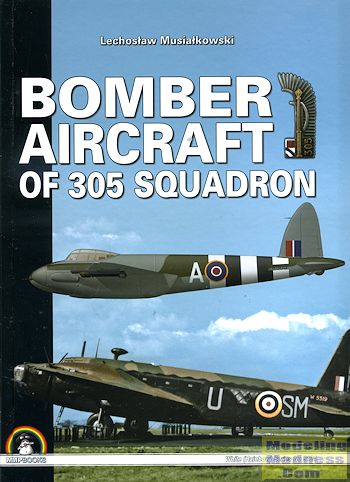MMP Books' Bomber Aircraft of 305 Squadron
|
Author: |
Lechosław Musiałkowski |
|
Publisher |
Mushroom Models
Publications |
|
Price |
$69.00 SRP from
Casemate Publishing |
|
Reviewer: |
Scott Van Aken
|
|
Notes: |
#9124
ISBN 978-83-61421-80-1
200 pages, hardbound, 8x12 inches |
 What few
people realize is that the largest number of non-Commonwealth aircrew serving in
the RAF during WWI came from Poland. Several squadrons of all types were formed
with Poles as their pilots and ground crew. Certainly not everyone in the units
were Polish, as there were often a lack of ground crew, but most pilots were.
What few
people realize is that the largest number of non-Commonwealth aircrew serving in
the RAF during WWI came from Poland. Several squadrons of all types were formed
with Poles as their pilots and ground crew. Certainly not everyone in the units
were Polish, as there were often a lack of ground crew, but most pilots were.
This is the story of 305 Squadron, one of the
bomber units that were part of the Polish Air Force in exile. Thanks to the
prolific photographs of F/Sgt Gabriel Miłosz, we have a very complete look at
the men and aircraft of 305 Squadron; enough to fill a book and that is only
with a percentage of the photographs taken.
Formed in August of 1940 it was the fourth and
final Polish bomber squadron. It used as its initial aircraft the Fairey Battle,
which fortunately, they used only for training and never had to take into
battle. This was followed by a series of Wellingtons, starting with the IA and
IC then moving on to the Merlin powered II and eventually the IV and the X.
While they started on some daylight ops, soon they switched to night work as the
Wellington proved to be too vulnerable to German defenses during the day.
After a couple of years on bombing and
mine-laying missions, the unit was moved to the 2nd TAF and they began flying
the Mitchell. This was a major improvement over the Wellington in both speed,
bomb load and crew comfort. However, it was not to last as only a few months
later they started getting the Mosquito FB.VI.
This aircraft was considerably faster than the
Mitchell and carried a smaller bomb load. It also carried a lot fewer crew
members leaving a bit of an 'excess' of personnel who were then sent off to
other bomber units. The Mossie was kept until the end of the war and
participated in a number of interesting special missions.
When the war was over, unlike other nations
who still flew with the RAF, Polish units were not allowed to paint on large
national insignia. This was all part of the deal that Churchill made with Stalin
to allowe the Soviets free reign to subjugate Poland after the war. 305 Squadron
stayed with the RAF until disbanded in December 1946. I doubt that many went
back to Poland, preferring the freedom of the west with the continued oppression
back in home, trading in the Nazis for the Soviets.
The book covers the complete operational
history of this unit from formation to disbandment, with a great deal of
information on missions and sorties. While not every mission is covered in
detail, some of them are and give the reader a taste of the unit's contribution
to the war effort, which was considerable. This is all superbly illustrated by
all those great period photos I mentioned at the beginning as well as the usual
profiles one gets with this line of books. It is not only great eye candy, but
makes for a superb read as well. A book that I very much enjoyed reading and can
highly recommend to you.
December 2014
Review book courtesy of
Casemate Publishing where
you can get yours.
If you would like your product reviewed fairly and fairly quickly, please contact
me or see other details in the Note to
Contributors.
 What few
people realize is that the largest number of non-Commonwealth aircrew serving in
the RAF during WWI came from Poland. Several squadrons of all types were formed
with Poles as their pilots and ground crew. Certainly not everyone in the units
were Polish, as there were often a lack of ground crew, but most pilots were.
What few
people realize is that the largest number of non-Commonwealth aircrew serving in
the RAF during WWI came from Poland. Several squadrons of all types were formed
with Poles as their pilots and ground crew. Certainly not everyone in the units
were Polish, as there were often a lack of ground crew, but most pilots were.